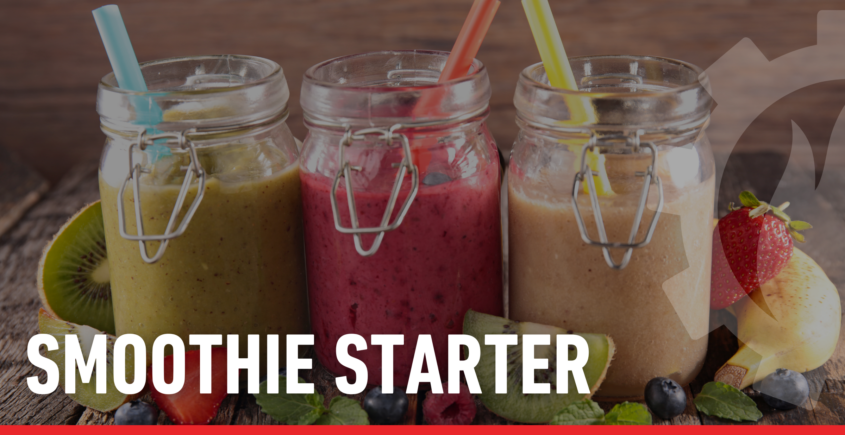Smoothie Starter
For me, sometimes starting the day with a tasty, fresh smoothie has to include peanut butter and spinach. Quick, light, and packed with just what I need to get going and begin solving your PIA (pain in the @%$) Jobs! When I get together with my buds, or the family for breakfast, it seems like someone selects traditional bacon and eggs – the most classic “go to” breakfast combo out there. Now my go-to combo is eggs over medium with corn beef hash (must be with those little chunks of potato!) and rye toast! Back in the day, hearty breakfasts like bacon and eggs were more common in farming communities or among laborers, but not everyday fare for the average person. With the price of eggs bouncing all over the place, and a box of cereal getting more expensive by the day, I got to wondering – what did people eat for breakfast years ago? What got them up and going long before smoothies, protein bars, and drive-thru coffee? From a leisurely plate of bacon and eggs to a nutrient-packed yogurt parfait, breakfast has always played a vital role in starting the day. But it hasn’t always looked the way it does now. Here’s a quick look back at how breakfast has evolved through the centuries, and how it’s still adapting today. Although for some of us, leftovers do make a wonderful breakfast also – just think spaghetti with meatballs!

By popular demand, we’re now sharing guides for the previous week’s logo contest!
Every Friday, scroll to the bottom of the post to review last week’s guide and see if we managed to stump you.
Stone Age Starts: Pancakes and Porridge – Believe it or not, breakfast goes back tens of thousands of years. Archaeologists believe that prehistoric people made early versions of pancakes by grinding up plants into flour, mixing them with water, and cooking them on hot rocks. Simple porridges, grains cooked in water, also likely served as hearty and nourishing morning meals.
Ancient Egypt: Beer please – peasants ate a daily meal, most likely in the morning, consisting of soup, beer, bread, and onions before they left for work in the fields or work commanded by the pharaohs. (Nothing like a beer to start the day???)
Greeks & Romans: (no yogurt yet): In Greek literature, there are numerous mentions of ariston, a meal taken not long after sunrise. The Iliad notes this meal concerning a labor-weary woodsman eager for a light repast to start his day, preparing it even as he is aching with exhaustion. Most recipes center around a pancake, with honey or nuts, or cheese. Romans called breakfast ientaculum, usually composed of everyday staples like bread, cheese, olives, salad, nuts, and raisins, and cold meat left over from the night before (today it’s a slice of pizza!). They also drank wine-based drinks such as mulsum, a mixture of wine, honey, and aromatic spices.
Middle Ages: Sop and Sustenance – In medieval Europe, breakfast was often light and simple, if eaten at all. A common dish was “sop,” which involved soaking stale bread in broth, wine, or milk. This humble dish is the precursor to later comfort foods like milk toast.
Early America: Beans, Fish, and the Rise of Regional Traditions – Pork and Beans became a breakfast staple in colonial New England. Recipes included salt pork, molasses, and long, slow baking—sometimes overnight in brick ovens. A cookbook from 1886 dubbed it “The Yankee dish for Sunday breakfast.” Codfish—yes, codfish!—was another beloved breakfast choice, often served in cream or fried into fish cakes. By 1914, the Waldorf Astoria in New York offered “Codfish in Cream” on its breakfast menu for 50 cents. Milk Toast grew in popularity in the late 19th and early 20th centuries. Made by pouring warm milk over buttered toast cubes, it could be sweet or savory. The term “milquetoast” (meaning timid or mild) comes from this soft, soothing dish. I would call this bread and milk, add sugar or strawberry jam – delicious!
Cold Cereal Revolution – Granula – James Caleb Jackson, a health reformer in New York, created the first cold cereal called Granula. It was made from baked graham flour, crumbled and re-baked into hard nuggets that had to be soaked overnight! John Harvey Kellogg, inspired by Jackson, developed his version—eventually called Granola after a legal tussle over the name. The era of the boxed breakfast had begun.
World War II Era: Creative Conservation – Meat Hash became a wartime breakfast staple when rationing limited access to fresh meat. Families mixed chopped leftovers—like beef, potatoes, and onions—with broth, then fried them into a filling hash. Companies like Armour encouraged using every scrap and even offered recipe booklets with ideas for breakfast hash using canned meats.
Bacon and Eggs and Edward Bernays: In the 1920s, Edward Bernays, a public relations pioneer (and the nephew of Sigmund Freud), was hired by the Beech-Nut Packing Company, which sold—yep—bacon. To boost bacon sales, Bernays launched a campaign to encourage Americans to eat a “hearty” breakfast. Consulting with a group of doctors, he asked if a heavier breakfast would be better for energy and health, and the doctors agreed (it could be). He used that medical endorsement to promote bacon and eggs as the ideal, “doctor-approved” breakfast—publishing it in newspapers and articles nationwide. Thanks to this PR campaign, bacon and eggs quickly caught on as the go-to morning meal for Americans.
Orange Juice Becomes a Breakfast Staple: In the late 1800s and early 1900s, oranges were enjoyed fresh, mainly in citrus-growing regions like California and Florida. Orange juice wasn’t widely consumed at first—there was no refrigeration, and it didn’t keep well once squeezed. In the 1920s, the California Fruit Growers Exchange (which later became Sunkist) wanted to increase orange sales. They launched a massive campaign encouraging people to drink orange juice as a way to get their daily dose of vitamin C. At the same time, the rise of nutrition science and public concern about illnesses like scurvy made vitamin C a hot topic, pitching OJ as a “healthful and refreshing morning beverage.” Slogans like “a day without orange juice is like a day without sunshine” weren’t just catchy—they were part of a full-blown marketing revolution that turned oranges into a billion-dollar breakfast tradition.
Why Steve’s Smoothies Are a Smart Breakfast Choice:
- Nutrient-Dense: Smoothies can pack in fruits, vegetables, healthy fats, protein, and fiber—all in one glass.
- Quick and Easy: Blend it in under 5 minutes and take it on the go. No cooking or dishes required.
- Customizable: Cater to your taste and health goals—low sugar, high protein, dairy-free, plant-based… You name it.
- Digestive Boost: Starting the day with blended fruits and greens gives your digestive system a gentle wake-up call.
- Hydration Help: Many smoothies contain a base of water, milk, or coconut water, helping you rehydrate after a night’s rest.
Ingredients: Mix and match from the categories below for a well-rounded, satisfying breakfast smoothie:
- Base Liquid: Almond milk, oat milk, Greek yogurt, coconut water, or plain water
- Fruits (fresh or frozen): Bananas (creamy & sweet), berries (antioxidants), mango, pineapple, or apple
- Vegetables: Spinach, kale, avocado, cucumber, or even cauliflower (you won’t taste it!)
- Protein: Greek yogurt, protein powder, nut butter, or silken tofu, peanut butter
- Healthy Fats: Chia seeds, flaxseeds, peanut butter, almond butter, or avocado
- Fiber & Superfoods: Oats, hemp hearts, cacao nibs, matcha powder, or cinnamon (NOT A FAN OF THESE!)
The Blender is the Key: Instructions:
- Toss everything you can find into a blender – my “must-haves”: Orange juice, a frozen banana, frozen mixed berries, Greek Vanilla Yogurt, fresh spinach, peanut butter (NOT CRUNCHY!) – absolutely amazing!
- Blend until smooth and creamy.
- Pour into your favorite glass or to-go cup and enjoy the glow!
- Pro Tip: Add ice for a thicker texture, or extra liquid if it’s too thick to blend.
With endless ingredient combos and the ability to sneak in a serving (or two) of fruits and veggies before 5 a.m., they’re a breakfast option that works as hard as you do.
Blend, sip, and go conquer your day!
How did you do on last week’s logo contest?
Check out our logo guide for the “Come Play With Me!” post here!






Leave a Reply
Want to join the discussion?Feel free to contribute!